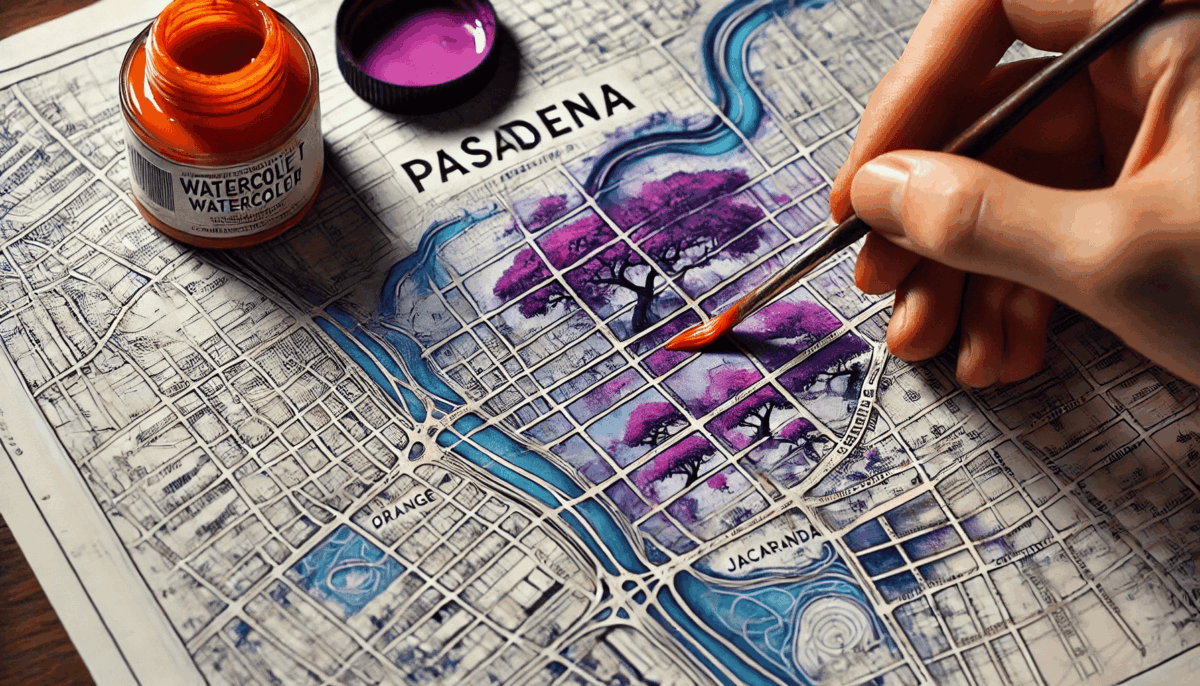To capture the essence of Pasadena in a bottle is to “bottle a Californian spring”—a delicate task that requires more than just an arrangement of pleasant scents. It calls for an olfactory translation of a unique landscape where urban architecture is softened by lush vegetation. Here, the perfumer must become both scientist and artist: distilling reality with technical precision and inventing the intangible through imagination.
The spring air of Pasadena is a layered composition, woven from the honeyed perfume of citrus blossoms and the visual splendor of blooming jacarandas. While orange blossoms deliver a well-known and richly nuanced scent, jacaranda flowers are famously elusive—gorgeous to look at, nearly scentless to the nose. This creates a fascinating challenge: one fragrance must be captured from nature; the other must be built from scratch. It is in this space of contrast that niche perfumery thrives, applying creativity and subconscious scent influence to evoke emotion.
This process becomes more than perfumery—it is sensory storytelling, a fragrant form of cartography. The ultimate goal is not merely to reproduce how Pasadena smells, but how it feels: sunlight through a purple canopy, sweetness warming the air, time suspended in bloom. It is this emotional fidelity, blending the authentic with the imagined, that transforms scent into memory and place.
The Challenge of Olfactory Realism
The primary hurdle in recreating Pasadena’s signature scents lies in their profoundly different natures. Orange blossom is a classic, tangible raw material in perfumery, rich with neroli, indole, and methyl anthranilate, offering a concrete target for the perfumer. The challenge here is one of balance and nuance—capturing its sun-warmed sweetness without veering into overly simplistic or soapy territory. It requires a high-definition olfactory snapshot of a living flower.
In stark contrast, the scent of jacaranda is an olfactory fantasy note. Because the flowers themselves produce no commercially extractable essential oil and have a very faint, almost undetectable scent, the perfumer must build the accord from the ground up. This is not a work of imitation but of poetic interpretation, translating the visual beauty of the purple-laden trees into a corresponding aroma. The perfumer must ask: what should a cascade of purple flowers smell like?
This dichotomy forces a perfumer to utilize two completely different skill sets, moving from precise chemistry to abstract artistry. For the orange blossom, they are a technician restoring a masterpiece, carefully analyzing and reconstructing a known chemical profile. For the jacaranda, they are a composer creating a new melody inspired by a silent muse, blending disparate notes to evoke an impression or a feeling. It is this blend of the scientifically accurate and the artistically imagined that defines the final creation.
Deconstructing the Orange Blossom
To accurately bottle the scent of orange blossom, perfumers draw from a sophisticated palette of both natural extracts and synthetic molecules. Each component is chosen to highlight a specific facet of the living flower’s complex aroma, from its bright citrus top notes to its warm, honeyed base. This process is less like mixing paint and more like assembling a high-fidelity sound system, where each piece adds a specific frequency to the overall experience.
The use of natural distillations and absolutes provides the heart and soul of the accord, lending an unparalleled depth and complexity that is difficult to replicate synthetically. These materials bring the earthy, slightly indolic, and richly floral character that grounds the fragrance in nature. However, relying on naturals alone can be limiting, often failing to capture the vibrant, effervescent quality of a blossom still on the branch. This is where a perfumer’s chemical knowledge becomes indispensable.
To achieve a truly lifelike and radiant effect, these naturals are meticulously augmented with specific aroma chemicals:
- Linalool: A key component of neroli, this molecule provides the fresh, slightly woody and floral lightness that defines the initial impression of the blossom.
- Methyl Anthranilate: This compound imparts the characteristic sweet, grape-like nuance that gives orange blossom its narcotic and heady depth.
- Indole: Used in trace amounts, this molecule adds a vital touch of animalic richness, giving the scent a realistic, “living flower” complexity and moving it away from a simple, clean floral.
Composing the Jacaranda Accord
Constructing the jacaranda accord is an exercise in pure olfactory poetry, where the perfumer acts as a composer creating a scent symphony inspired by a color and a feeling. Since there is no natural blueprint, the process begins with an idea—a soft, watery, ethereal floralcy that mirrors the visual grace of the blossoms. The accord is built piece by piece, blending molecules and materials that contribute to this central concept of “purple air.”
The foundation of the accord is often a watery or ozonic note, designed to evoke the feeling of a gentle breeze carrying a hint of moisture and pollen. This creates a sense of transparency and space, preventing the accord from becoming a heavy, traditional floral. Molecules like Calone or Helional can be used to create this aqueous, airy canvas upon which the other, more colorful notes are painted. This process is a perfect illustration of how modern perfumery can create scents that exist in the imagination rather than in nature.
Upon this watery base, the perfumer carefully layers soft floral and green notes to build the “purple” impression. This often involves a delicate balance of materials that suggest the color without being overly sweet or loud. A hint of violet from ionones, a touch of powdery mimosa, or the cool, green freshness of hedione can be blended to create a soft-focus floral effect that feels both gentle and pervasive, just like the jacaranda-lined streets of Pasadena.
Niche Perfumery as a Storyteller
This kind of specific, atmospheric fragrance creation finds its natural home in the world of niche perfumery. Unlike mass-market brands that must appeal to the broadest possible global audience, niche houses have the freedom to tell more personal and geographically focused stories. They can invest in creating a “scent postcard” from Pasadena because their audience values artistry and a unique point of view over universal likeability.
The creation of a fantasy accord like jacaranda, in particular, is a hallmark of the niche approach. It requires a willingness to engage in olfactory storytelling, prioritizing an evocative concept over a simple, recognizable smell. This is a risk that larger commercial houses are often unwilling to take, preferring to work with proven, popular notes. Niche perfumery thrives on this creative freedom, allowing perfumers to explore abstract ideas and translate them into wearable art.
Ultimately, fragrances like those inspired by Pasadena serve a different purpose than their mainstream counterparts. They are not merely designed to make the wearer smell good, but to transport them to a specific place and time. They offer an experience, a memory, and a connection to a location, real or imagined. This focus on narrative and emotional resonance is the defining characteristic of niche perfumery and why it is the perfect medium for capturing the soul of a city.
Frequently Asked Questions
No, it does not. The jacaranda flower is what is known in perfumery as a “mute flower,” meaning that while it may have a faint scent in nature, it does not produce enough aromatic compounds to make commercial extraction of an essential oil or absolute feasible. The scent in perfumes is always a creative reconstruction.
Both come from the blossom of the bitter orange tree, but they are extracted differently. Neroli is produced via steam distillation, which captures the lighter, greener, and fresher aspects of the flower. Orange blossom absolute is created through solvent extraction, which results in a much richer, deeper, sweeter, and more indolic scent that is closer to the smell of the living flower.
To create a full atmospheric picture, perfumers often complement the main floral notes with other scents associated with the Southern California environment. These can include green, slightly bitter notes of petitgrain (distilled from the twigs and leaves of the orange tree), the dusty scent of sun-baked earth, or a bright, citrusy top note of grapefruit or pomelo to evoke the feeling of California sunshine.

